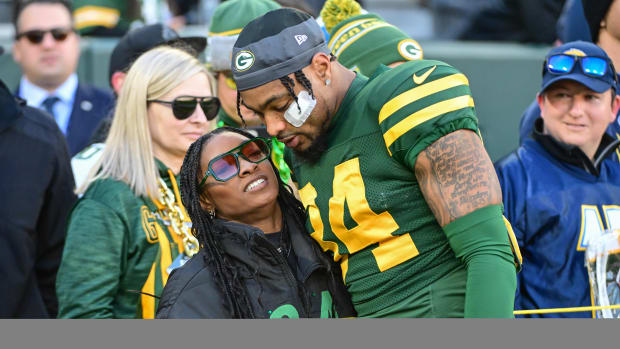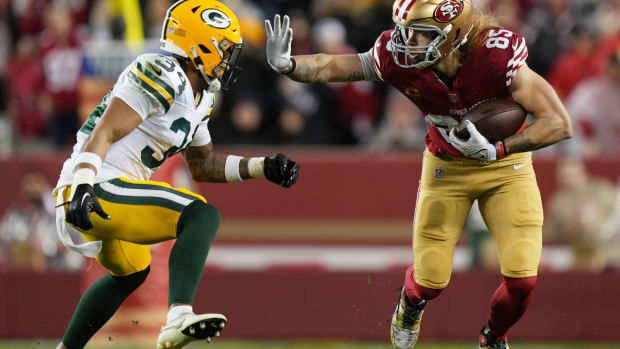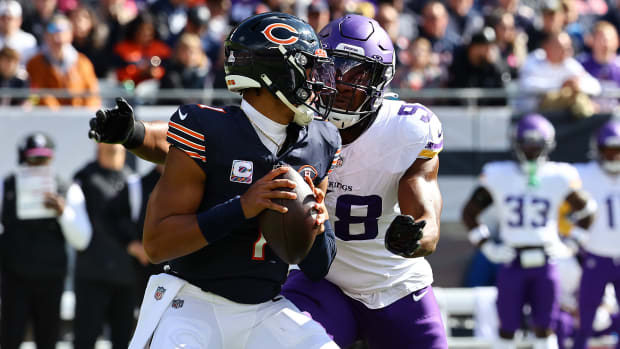Three Problems with Matt Nagy's Approach
In the first four days of Bears practice, the general plan Matt Nagy has on offense for this season became apparent.
It's going to include bigger chunks of yards in the passing game, using the speed the Bears have found in Damiere Byrd and Marquise Goodwin either to go downfield more or to open up the attack.
It will include speed at various positions playing in multiple spots to keep the defense off balance and also help prevent teams from ganging up on Allen Robinson.
"I think the one thing that is really neat about our guys and with A-Rob now going into his fourth year in this offense, we can move him around in a lot of different positions," Nagy said. "We've been able to do that from Day 1 but he gives us some great flexibility there. Same thing with (Darnell) Mooney. You know last year he played our Z position and this year, again, we can do different things.
"What I like about these wide receivers that we have and what our wide receivers we've had in the past is that they all understand the objectives. We call it musical chairs, meaning the Z, the X and the 'Zebra position,' when we're in 11-personnel. In a perfect world we want as many guys as possible to know all three positions. I think we're at a pretty good place right now where we're able to do that."
Nagy vies Goodwin and Byrd as great assets because of their speed and adaptability.
"We all know they're guys that are super-fast that have experience in this game, but it gives us a chance to move guys around and put them in spots that we feel are advantageous," Nagy said. "They've accepted it. We are challenging our offense right now with a lot of different things conceptually and right now, you know, it's early. But right not they're doing pretty good."
It sounds so well conceived on paper. Byrd described the task he and the other receivers are facing.
"Throughout my career, I've always had to know every position," Byrd said. "For whatever reason, I've always ended up outside and I think that's where I excelled at the most. And now we have a lot of guys who can interchange and be interchangeable parts.
"Being able to be in the slot or be outside, that's going to be the role. You've got to learn it and perfect it and that's what I expect to do."
If they get those players downfield, make the threat real, it opens up the underneath for catch and run by Cole Kmet and Jimmy Graham, for running backs David Montgomery and Damien Williams. Even Robinson might not have as many people draped on him when he catches a pass so that he'll be able to gain a few yards after the catch for a change.
The key word Nagy used in all of this is "conceptually."
Nagy might do well to heed the words of his own safety, Tashaun Gipson.
"I would say there are sometimes in a practice where you can get a little bit excited or in the middle of a practice because something goes a certain way and I think I'm a little more calm this year," Gipson said this past week.
Nagy needs to do the same an dial it down a bit with enthusiasm about this offense's ability, take more of a wait-and-see approach. What he might see as success in practice in the catches being made because of versatile, fast receivers could ultimately be a problem for three reasons.
3. Receiver talent
Mooney proved himself last year. There was no doubt about this. And he showed he can handle more in the offense in order to accept a role expanded beyond "Z" receiver.
Byrd and Goodwin are the problem. They might have speed, but the Bears are counting on getting something out of them which hasn't been shown to date. For these two to succeed as receiving threats to the extent they can punish teams for overemphasizing Robinson in coverage requires something neither has shown to date: consistency.
These are receivers who basically have been cast off by other teams for not producing day to day.
Byrd gradually has upped his production but until last year it never was to a level where a team could count on them as key performers. Byrd never had more than 33 catches until he went to the Patriots last year and they used him for 47 receptions in a a receiver group short on talent, and with a quarterback who wasn't entirely familiar with their offense. In fact, Cam Newton knew Byrd better than he did the Patriots offense since they played together in Carolina, where Byrd had 20 catches in three years.
So we are to expect Byrd, with his fourth team in four seasons, now in his seventh season, has the ability to hurt teams with his speed when he hasn't averaged more than 12.9 yards a catch for any year except when he made one catch as a rookie.
The situation with Goodwin is different. He has had one decent year with 56 catches in San Francisco, and has averaged 16.6 yards a catch for his career.
He also comes up unavailable due to minor or nagging injuries often. Of 112 games possible, he's played in only 75 without a real devastating injury involved.
"People like to say that Marquise is a track guy who plays football," Nagy said. "That couldn't be more opposite of what he is."
Wrong. That couldn't be more accurate.
The term "track guys" in football has several connotations, none good. One is that the slightest little injury takes a player out of his game or the game entirely.
Track athletes are finely tuned to beat a standard and when not at optimum performance level they're really no use to themselves. You don't find guys gutting out a win with a bad leg in the open 400 meters or in steeplechase. They're either physically able to do it that day or they're not.
It's different in football. Cunning, ability to run routes differently and find ways to get open can offset the speed factor and help a receiver who's less than 100% healthy. Rarely is any football player 100%.
This brings up the main mistake they've made with this, which is route-running. This ability is everything for every receiver.
If Byrd was effective at it, why did Bill Belichick let him leave to sign for only $1.13 million in Chicago or why did San Francisco first trade Goodwin and then cut him when the trade was negated so he could sign for only $1.2 million in Chicago?
Wait until actual defense is being played and it's not practice, as Gipson spoke about. When receivers have to take contact in games or practice, their speed suddenly looks different, and their routes do as well. It might even show up in practice when they put on pads.
2. The tackles
The Bears haven't been able to block their own defense this week in passing situations, let alone worry about others. Without injured Teven Jenkins and Germain Ifedi, Robert Quinn and Khalil Mack have found it very easy to harass Andy Dalton or Justin Fields. On Saturday, Fields was even down on the ground once and that's not supposed to happen in practice.
Even with them, no one can be sure how it will work because Jenkins is a rookie who must prove himself.
When you're counting on speed receivers running deeper routes, you need more time to pass.
It's going to require a lot of help for the tackles in pass blocking from backs or tight ends even for good tackles, let alone an inexperienced one and one who was actually acquired to play guard, like Ifedi.
Before they can even know if this is possible, the players need to be on the field.
3. Matt Nagy
Is he going to blend in the right amount of running with this deeper passing game to make it all work. This team's staple has not been play-action, although it easily could be with David Montgomery as a running threat and now Damien Williams, as well.
How is Nagy going to be as a play-caller now after pulling himself off the job last year?
"We were in a funk and it needed to be done," Nagy said. "At the same time, I do have a lot of belief and confidence in myself and the way that I've learned when to call plays at certain times. Personnel-wise, formations, motions, shifts. All that stuff. And then even schematically, it's relying and trusting in your coaches that are there in between the series of plays in the game. I think we got better.
"I told you that last year we got better in communicating on the sideline in between series, which has helped all of us out. So now this year, I need to be able to do that and use that. And then communicate with the quarterbacks and make sure we're all feeling or seeing the same stuff."
This the third unknown element or place where they're resting their faith in this overall plan.
Can Nagy change? Can receivers who haven't had the ability to alter their teams elsewhere suddenly do it in Chicago? Can tackles who aren't even on the field suddenly spring to action and make it all possible to work?
There's too much being left to faith.
Twitter: BearDigest@BearsOnMaven




